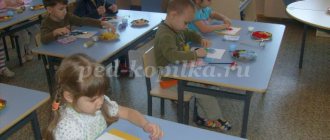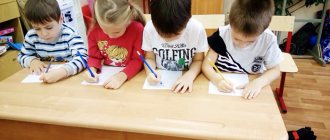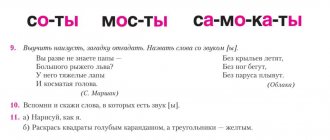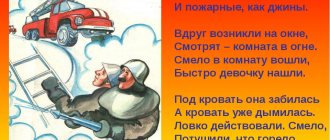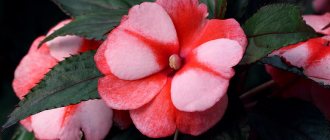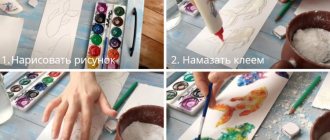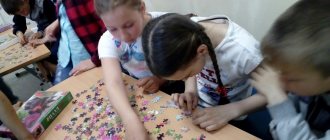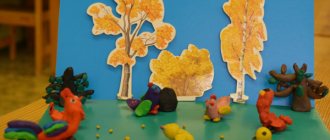Summary of the lesson “Agricultural professions” (senior group)
Summary of the lesson “Agricultural professions” (senior group)
Objectives: Educational: to reinforce with children the names of agricultural professions, to expand knowledge about work in the village;
Developmental: to form the moral qualities of the child’s personality: independence, respect for work, patriotism; develop speech, enrich children’s vocabulary, continue to develop memory, attention, thinking, develop cognitive interest
Educational: to cultivate a love of nature, to cultivate respect for working people, to cultivate interest in blue-collar professions
Preliminary work. Reading
fiction: (stories by L.F. Voronkova “Sunny Day”, V. Sokolovsky “Milk River, Kiselnye Banks”, K.D. Ushinsky
"Caring Cow"); examination of reproductions of paintings by artists: A. Plastov “Summer”, I.I. Shishkina
"Rye"; reading poems by writers: A.A. Fet “The rye is ripening over the hot cornfield...”, E. Trutneva “Golden Corridor”; conversations about pets in rural areas. Excursion to the farm SPK PMZ "Dmitrievy Gory"
Equipment. Illustrations, pictures of people in the professions of animal husbandry: milkmaid, calf shepherd, veterinarian, shepherd, machine operator; pictures of cows, a herd of cows, a farm, a milking machine; multimedia projector with a presentation about professions on the farm; tape recorder for physical education.
Educator: Once upon a time, people
They learned not just to hunt animals, but to specifically breed them. This activity is called agriculture. Agricultural workers need to know a lot about plants and animals, be able to properly grow and care for them. But the main thing, guys, is that more than anything in the world you need to love the earth. Without this you cannot achieve good results.
Agricultural workers put a lot of work into growing a good harvest, so that domestic animals produce more milk, meat, and eggs; Their work is not easy, it takes a lot of effort and time. Nowadays, agricultural workers' work is made easier by technology, which they must understand well. After all, to plow the land
To sow grain, to cut hay to feed cows, sheep and horses, you need to be able to handle special equipment: tractors, mowing machines, combines, watering machines. Therefore, agriculture cannot do without special professions. Today we will get acquainted with different
our professions in the countryside.
Educator. Guys, do you like to solve riddles? Guess it!
White water
It will be useful to all of us. From white water
Do whatever you want: Cream, yogurt, Butter for our porridge, Cottage cheese for a pie - Eat it, Vanyusha - my friend! Eat and drink, serve for the guests, and don’t be sorry for the cat!
Educator. That's right, you guessed it, it's milk. Where does milk come from? Guess the riddles and you will immediately find out.
Educator. “It’s motley, it eats green, it gives white,” “In the middle of the yard there is a haystack: in front there is a pitchfork, in the back there is a broom.”
Children. A cow, she gives milk. Educator. Of course, this is co-
mova. What animal is a cow? Why?
Child. A domestic animal lives near a person’s house, and the person takes care of it.
Educator. One cow produces as much milk as one family needs. Where can we get milk to feed all the children in kindergarten, all the big cities, since milk is on our table every day? (Children’s answers)
Educator. Large farms are being created in villages, where many, many cows are kept. They are looked after by special people from different professions. Today we will get to know them.
Round dance game “We walked through the woods”
We walked through the woods
And we met a matryoshka. (children walk in a circle)
“I’m tired,” she says (palms pressed to cheeks)
My leg hurts (hands on my belt, shaking my leg)
You, matryoshka, don’t be sad! (pat the neighbor standing next to him on the shoulder) You need to rest! (squats,
hands under the cheek)
And then get ready
Then hit the road by car! (walk in a circle)
Children sit on chairs.
Educator. A long time ago, people learned to specifically breed domestic animals. This type of human activity is called animal husbandry.
(Show children pictures of a farm)
Educator. A milkmaid and a machine operator work at the farm to care for the animals. The machine operator prepares feed for the animals and ensures that all mechanical equipment works on the farm.
Educator. Who knows what cows eat?
Children. In summer - grass, in winter - hay.
Educator. That's right, but not only this, cows need a wide variety of food.
Topic: “Vegetable garden. Vegetables. Harvesting. Agricultural professions"
Transcript
1 “Vegetable garden. Vegetables. Harvesting. Agricultural professions" 1. Examine natural vegetables or pictures with the child, name, name the color of the vegetable, its shape. Let your child hold the vegetable in his hands and ask him to touch it with his eyes closed. Play the game “What’s missing?”: choose from 3-4 vegetables or pictures. 2. Finger game “Cabbage” We chop the cabbage (movements with our palms up and down) We three carrots (fingers clenched into fists, movements back and forth) We salt the cabbage (imitate movements with three fingers) We press the cabbage (clench and unclench our fists) 3 .Color with colored pencils.
2 “Animals and Birds” 1. Does your child know wild animals and can they name them correctly? Train your child in recognizing and naming a bear, wolf, fox, hare in pictures in books. 2. Looking at the animals in the book, help your child make sentences with these verbs using questions: What is the bunny doing? The bunny is jumping. What is the fox doing? The fox is running. What is the bear doing? The bear is sleeping. What is the wolf doing? The wolf is standing. 3. Read to your child and teach him short rhymes. Praise your child if he wants to tell them with you. The fox has a fluffy tail, it’s not for nothing that she’s proud of it. Misha went to bed in his den. Do not make noise! Quiet! Quiet! 4. Read the Russian folk tale “The Wolf and the Little Goats” to your child, talk to the child about it, asking questions: door? - Who is this fairy tale about? -Who had a house in the forest? -What song did the goat sing? -Who overheard the song? -How did the wolf sing the song? - Why did the kids open 5. Color with colored pencils: o
3 “Winter” 1. Talk with your child about the time of year that has arrived. Repeat the word winter with him. Ask him to say the word himself. Fix the answer to the question: 2. Make snowflakes from paper or cotton wool (loose lumps). Explain to the child what snowfall is and invite the child to blow “snowflakes” from the palm of his hand. What time of year is it now? It's winter now. 3. Talk to your child while walking about winter, observe its signs. Consider how different snowflakes are. 4. Read a poem about snowflakes to your child. SNOWFLAKES I stand and catch snowflakes in my palm. I love winter, and snow, and snowflakes. But where are the snowflakes? There is water in your palm! Where have the snowflakes gone? Where? The fragile pieces of ice-rays have melted... As you can see, my palms are hot. 5. Color the snowflakes, draw your own
4 “Winter fun and entertainment” 1. Talk with your child during a walk about winter (fasten), children’s fun in winter. Ask your child to repeat after you the words sled, ski, skate, slide. If possible, look at pictures depicting winter fun, ask your child questions about the content of the pictures. 2. Together with your child, come up with a short story about a snowman, then ask the child to tell the story on his own. Color it. 3. Finger gymnastics (daily). Speak the text together with the child. “WE WENT INTO THE YARD FOR A WALK” One, two, three, four, five, We came into the yard for a walk. with the middle fingers.) They sculpted a snow woman, (Bend their fingers one at a time.) (“Walk” along the table with their index fingers and (“Make” a lump with two palms.) They fed the birds with crumbs, (“Crumble bread” with all their fingers.) Then we rode down the hill , in the palm of the left hand.) And they were also lying in the snow. (They place their palms on the table, first on one side, then on the other.) They came. palms.) Everyone in the snow goes home (Shaking them off. They ate the soup and went to bed. (Moves with an imaginary spoon; hands under the head.) (Leads with the index finger of the right hand
5 “New Year's holiday. New Year's tree holiday" 1. Talk to your child about the upcoming holiday. Tell us that this is a New Year's Eve celebration. Find out if the child remembers who all the children are expecting with gifts on this day. Invite your child to repeat after you the words and phrases: New Year, Christmas tree, Santa Claus, Snow Maiden, holiday, round dance, gifts. 2. Involve your child in decorating the Christmas tree. Look at Christmas tree decorations with him. Help me tell you what they are. Practice the pronunciation of the adjectives light, brilliant, big, beautiful, etc. 3. Breathing exercises “Let’s warm our palms.” Children put their palms to their mouths and breathe warm air on them. 4. Finger gymnastics “ON THE TREE” We had fun on the Christmas tree, and danced and frolicked. Afterwards, kind Santa Claus presented us with gifts. He gave them huge bags, containing delicious items: (Make rhythmic claps) Candies in blue pieces of paper, (Bend the fingers on both hands, Nuts next to them, starting with the big one) tangerine. Pear, apple, one golden 5.Color. (Rhythmic hand clapping) (Rhythmic fist bumps) (Children “walk” with the middle and index fingers of both hands on the table) (“Draw” a large circle with their hands)
6 “Defender of the Fatherland Day” 1. Talk with your child about the holiday that we are preparing to celebrate. This is Defender of the Fatherland Day. Tell us about the professions of the military: pilot, sailor, border guard, tank driver. Tell them that they protect the peace of civilians and protect their native land from enemies. 2. Finger gymnastics “Well done fighters” These fingers are all fighters, (Children show palms with straightened fingers) Daring fellows. Very nice boys! One two three four five. (They clench and unclench the fingers of both hands.) (Alternately count the fingers on the left hand, starting with the little finger, then on the right hand.) One, two, three, four, five (They clench and unclench the fingers of both hands) Let's count the good guys. The fingers stood together in a row - Ten strong soldiers. 3. Color with colored pencils. (Show palms, spread fingers and bring them together.) (Show palms with straight
7 “Transport. Traffic rules" 1. Chat, does your child know the names of the types of transport that can be found on the streets of the city, does he know how to correctly name a car, bus, truck, tram? While walking with your child, watch the transport, practice naming the transport and its parts (wheel, cabin, steering wheel, body). At home, use pictures in books for this. 2. While watching the transport while walking, invite your child to answer questions and make sentences. Who's on the bus? What does the car carry? Who gets off the bus? Who's driving the bus? 3. Learn: This driver is an excellent cat. The driver is driving the truck. 4. Do moving exercises with your child. Let your child say the text with you. TRUCK The truck is carrying sand. We walk in a circle, pretending to turn the steering wheel. People are surprised: We stop, turn our faces in a circle, spread our arms, and make a surprised face. “So miracles, miracles. There is sand in it to the heavens." We stretch on our toes, raising our hands up. 4. Color the picture and draw a car in your notebook. We tilt our head left and right twice.
